Elemento
COVID-19 outbreaks threaten migrant, officer safety at cramped detention centers, advocates say
Media
Título (Dublin Core)
COVID-19 outbreaks threaten migrant, officer safety at cramped detention centers, advocates say
Description (Dublin Core)
by Jessica Myers| Luce Foundation: Southwest Stories Fellowship
.
In the six months Maria Chávez’s husband has been detained at La Palma Correctional Center, he has been quarantined twice after being exposed to suspected cases of COVID-19.
And quarantine, for him, has meant solitary confinement. Andrés gets 20 minutes a day outside his cell, Chávez said, which he first uses to call his wife of 29 years and family. He uses the remaining time to shower.
“Any normal person would get depressed in quarantine, locked up for almost 24 hours a day,” Chávez said in Spanish. “For those of us on the outside, it’s different. But for the person that’s inside, it’s enough to drive you crazy.”
La Palma, which can house up to 3,060 detainees, is one of two privately run Immigration and Customs Enforcement facilities in Eloy, Arizona. The other, Eloy Detention Center, can hold up to 1,456 people.
At the end of July, there were 252 positive COVID-19 cases at Eloy and 108 positive cases in La Palma. Among the roughly 4,000 detainees who had tested positive for the virus as of late July, ICE data showed Eloy Detention Center had the third-highest number of positive cases in the country, after facilities in Washington, D.C., and Texas.
Migrant rights activists suspect official numbers don’t tell the full story — given the lack of comprehensive testing at detention facilities, they say, it’s likely COVID-19 has sickened or infected many more detainees. But officials from ICE and CoreCivic, which owns and operates both Eloy facilities, have defended their handling of the pandemic, saying they’ve relied on federal guidelines to protect employees and “those entrusted to our care.”
Lawsuits filed throughout the country argue those measures have fallen short. Migrant advocacy groups say the facilities’ poor ventilation and small, enclosed spaces put detainees — many of whom are seeking asylum in the United States — at high risk of contracting COVID-19.
They contend release is the “only appropriate remedy.”
And quarantine, for him, has meant solitary confinement. Andrés gets 20 minutes a day outside his cell, Chávez said, which he first uses to call his wife of 29 years and family. He uses the remaining time to shower.
“Any normal person would get depressed in quarantine, locked up for almost 24 hours a day,” Chávez said in Spanish. “For those of us on the outside, it’s different. But for the person that’s inside, it’s enough to drive you crazy.”
La Palma, which can house up to 3,060 detainees, is one of two privately run Immigration and Customs Enforcement facilities in Eloy, Arizona. The other, Eloy Detention Center, can hold up to 1,456 people.
At the end of July, there were 252 positive COVID-19 cases at Eloy and 108 positive cases in La Palma. Among the roughly 4,000 detainees who had tested positive for the virus as of late July, ICE data showed Eloy Detention Center had the third-highest number of positive cases in the country, after facilities in Washington, D.C., and Texas.
Migrant rights activists suspect official numbers don’t tell the full story — given the lack of comprehensive testing at detention facilities, they say, it’s likely COVID-19 has sickened or infected many more detainees. But officials from ICE and CoreCivic, which owns and operates both Eloy facilities, have defended their handling of the pandemic, saying they’ve relied on federal guidelines to protect employees and “those entrusted to our care.”
Lawsuits filed throughout the country argue those measures have fallen short. Migrant advocacy groups say the facilities’ poor ventilation and small, enclosed spaces put detainees — many of whom are seeking asylum in the United States — at high risk of contracting COVID-19.
They contend release is the “only appropriate remedy.”
Photo Credit: Peg Hunter/Creative Commons.
Date (Dublin Core)
August 7, 2020
Creator (Dublin Core)
Jessica Myers
Contributor (Dublin Core)
Jessica Myers
Event Identifier (Dublin Core)
Cronkite-Luce Fellowship
Partner (Dublin Core)
Arizona State University
Tipo (Dublin Core)
article
Controlled Vocabulary (Dublin Core)
English
Immigration
English
Health & Wellness
English
Social Issues
English
Social Distance
Curator's Tags (Omeka Classic)
#lucegrant
ICE
migrants
detainees
solitary
quarantine
Eloy
Collection (Dublin Core)
Luce Grant
Law Enforcement
Latino(a/x) Voices
Exhibit (Dublin Core)
Southwest Stories>Incarceration Stories
Southwest Stories>Jessica Myers
Date Submitted (Dublin Core)
08/12/2020
Date Modified (Dublin Core)
08/12/2020
02/05/2021
06/15/2021
07/15/2021
05/24/2022
Recursos enlazados
Filtrar por propiedad
| Título | Etiqueta alternativa | Clase |
|---|---|---|
 COVID-19 threatens migrant, officer safety at cramped ICE detention centers COVID-19 threatens migrant, officer safety at cramped ICE detention centers |
Linked Data | Interactive Resource |
This item was submitted on August 12, 2020 by Jessica Myers using the form “Share Your Story” on the site “A Journal of the Plague Year”: http://mail.covid-19archive.org/s/archive
Click here to view the collected data.
